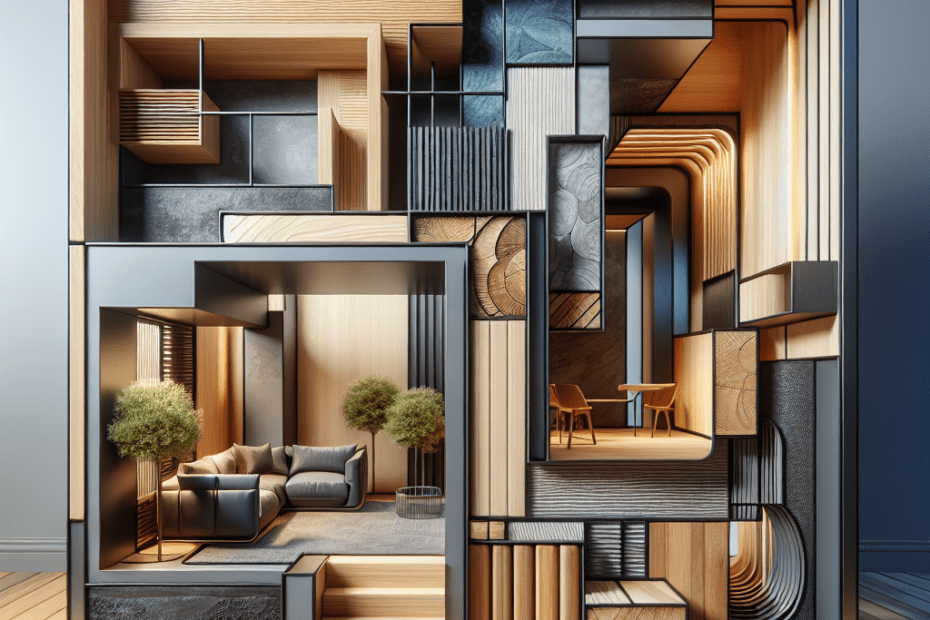“`html
The Bold Beauty of Mixed Materials in Contemporary Design
In contemporary design, creativity thrives when different elements come together. They transcend tradition, merging diverse materials to create something extraordinary. This innovative trend, known as mixed materials in contemporary design, captivates the imagination and transforms living and working spaces into works of art.
For home renovators and designers alike, using mixed materials in contemporary design provides an opportunity to experiment with textures, colors, and patterns. This method offers a fresh perspective, moving beyond the limits of conventional creativity. Consider the widespread use of metal, wood, glass, textiles, and stone to create a distinct identity in interior spaces and furniture designs.
The Rise of Mixed Materials
The allure of mixed materials lies in their ability to add depth and interest while maintaining functionality. According to a report by Statista, over 70% of interior designers in 2023 favor incorporating mixed materials as a means to achieve innovative and personalized aesthetics.
Popular Combinations in Contemporary Design
Combining different materials introduces visual interest through contrast and complementarity. Here are some popular combinations widely favored:
| Material Combination | Description |
|---|---|
| Wood & Metal | Blends warmth and industrial elegance for a timeless effect. Often used in furniture and fixtures. |
| Glass & Stone | Provides transparency juxtaposed with solidity, ideal for sleek modern aesthetics in kitchens and bathrooms. |
| Textile & Leather | Adds texture and depth to furnishings like sofas and chairs, offering both comfort and durability. |
The Aesthetic and Functionality of Mixed Materials
Using mixed materials enhances aesthetic appeal while optimizing functionality. Harmonizing different materials allows designers to exploit each element’s strength. For instance, metal offers strength and sleekness, while wood imparts warmth and grounding.
Blending materials supports environmental responsibility. Reclaimed wood, recycled metals, and sustainable textiles can effortlessly integrate within the framework of contemporary designs, contributing to eco-friendly solutions.
Applications Across Different Design Fields
Mixed materials are not confined to interior spaces alone. Architects and artists use this concept to push boundaries in various fields:
- Architecture: Façades that combine glass, steel, and stone not only enhance aesthetic beauty but improve energy efficiency.
- Furniture Design: Chairs, tables, and shelving units blend different textures for visual interest and practical functionality.
- Lighting Design: Pendant lights and chandeliers that combine metal and glass create both modern and vintage appeals.
Challenges and Considerations
While mixing materials offers many advantages, it requires balance and careful consideration to avoid clutter and discordance. Designers need to harmonize scale, texture, and color. Furthermore, staying current with design trends remains vital to ensure aesthetic appeal aligns with consumers’ evolving preferences.
Impact on Market Trends
The use of mixed materials in contemporary design continues to expand. Market trends indicate that this approach will shape the future of interior and architectural design. According to a survey by Architectural Digest, 65% of consumers expressed a preference for designs incorporating mixed materials, suggesting a growing demand that drives ongoing innovation.
Key Takeaways
- Mixed materials in contemporary design blend different elements to create eclectic styles that enhance both beauty and function.
- Popular combinations include wood with metal, glass with stone, and textile with leather.
- These designs promote sustainability through the use of recycled and eco-friendly materials.
- Mixed materials influence a wide range of fields including architecture, furniture, and lighting design.
- Designers and homeowners need to balance materials carefully to achieve harmony and avoid overwhelming spaces.
FAQ
- What are mixed materials in contemporary design?
Mixed materials in contemporary design involve the use of various materials together to create visually compelling and functionally optimized spaces. - What are the benefits of using mixed materials?
Mixed materials bring diversity in texture, color, and function, support sustainable practices, and offer opportunities for personalization and innovation. - Can mixed materials be used in outdoor spaces?
Yes, mixed materials are often used in outdoor spaces to create dynamic furniture, patios, and garden features that withstand weather conditions. - How do mixed materials contribute to sustainability?
By incorporating recycled and reclaimed materials, mixed materials reduce waste and promote eco-friendly practices. - Do mixed materials add value to property?
Yes, well-designed mixed material interiors and exteriors can boost aesthetic appeal and property value due to their modern and sustainable appeal.
“`
